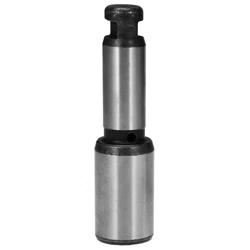Loading ...
Loading ...
Loading ...

2. Mount motor control box (3-wire pump) or
fused disconnect switch (2-wire pump) in a
permanently weather proof place. Make sure
that controls will not be subjected to
extreme heat or excess moisture.
3. Make sure controls are in OFF position.
4. Connect motor leads and power supply
wires to motor control box or magnetic
starter (see Wiring Diagrams). DO NOT
START PUMP YET.
5. Set gate valve on discharge 1/3 open; start
pump (see Figure 11).
6. Keep gate valve at this setting while water
pumps out onto ground. Let it run until water
is clear of sand or silt. (To check solids in
water, fill a glass from pump and let solids
settle out).
7. When water is completely clear at 1/3 set-
ting, open gate valve to approximately two-
thirds open and repeat process.
8. When water is completely clear at 2/3 set-
ting, open gate valve completely and run
pump until water is completely clear.
9. Remove gate valve for permanent installation
near tank (see Figures 12 and 13, Pages 8
and 9).
10.Install sanitary well seal or pitless adapter
unit, well unit, electrical conduit and surface
piping according to local code requirements
that apply.
CONNECTING TO TANK/WATER SYSTEM
Hazardous pressure. Submersible
pumps can develop very high pressure in some
situations. To prevent tank blowup, install a
pressure relief valve able to pass full pump flow
at 75 PSI (517kPa) when using an air over
water pressure tank. Install a pressure relief
valve capable of passing entire pump flow at
100 PSI (690 kPa) when using a pre-charged
pressure tank. Install this relief valve between
pump and tank.
Pipe joint compound can cause
cracking in plastics. Use only teflon tape on
joints in plastic pipe.
NOTICE: Allowing pump or piping system to
freeze may severely damage pump and will void
warranty. Protect pump and entire piping system
(including pressure tank) from freezing.
Pre-charged Pressure Tank Hookup:
See Figure 12, Page 8 for piping connections to
pre-charged pressure tank.
NOTICE: Check air pre-charge in tank before
starting pump. Adjust pre-charge to 2 PSI below
pump cut-in setting. (For example, a pre-charge
tank used with a 30-50 switch should be pre-
charged with air to 28 PSI. Adjust pre-charge by
either adding or bleeding air through tire valve
located on top of tank. Check pre-charge annu-
ally and adjust as needed.
Standard Tank Hookup:
See Figure 13, Page 9 for piping connections to
standard pressure tank and for correct distance
of bleeder orifices from pressure tank.
7
Important Electrical
Grounding Information
Hazardous voltage. Can shock,
burn, or kill.To reduce the risk of electrical
shock during pump operation, ground and
bond the pump and motor as follows:
A. To reduce risk of electrical shock from metal
parts of the assembly other than the pump,
bond together all metal parts accessible at the
well head (including metal discharge pipe,
metal well casing, and the like). Use a metal
bonding conductor at least as large as the
power cable conductors running down the well
to the pump's motor.
B. Clamp or weld (or both if necessary) this
bonding conductor to the grounding means
provided with the pump, which will be the
equipment-grounding terminal, the grounding
conductor on the pump housing, or an equip-
ment-grounding lead.The equipment-ground-
ing lead, when provided, will be the conductor
having green insulation; it may also have one
or more yellow stripes.
C. Ground the pump, motor, and any metallic
conduit that carries power cable conductors.
Ground these back to the service by connect-
ing a copper conductor from the pump, motor,
and conduit to the grounding screw provided
within the supply-connection box wiring com-
partment.This conductor must be at least as
large as the circuit conductors supplying the
pump.
Save these instructions.
Loading ...
Loading ...
Loading ...
